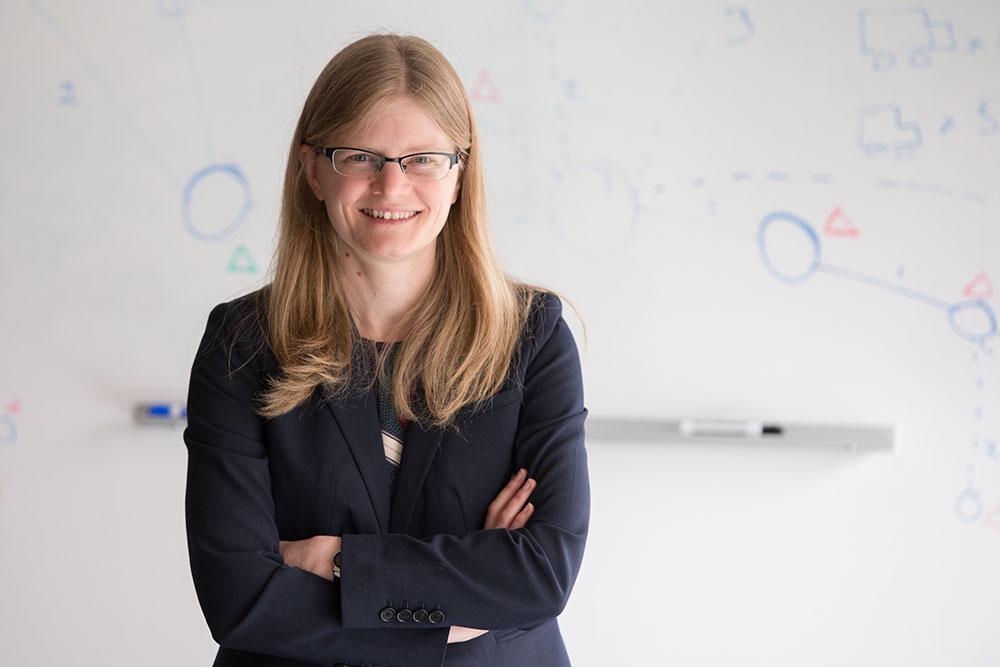A professor from the School of Engineering and Applied Science hopes to implement a model that will speed up the turnaround time of test results in the University’s COVID-19 lab this summer.
Erica Gralla, an associate professor of systems engineering, said she has been conducting research at the University of Maryland since the start of the pandemic. During her research, she found that back-end testing issues that arise in the lab, such as removing swabs from test tubes, are tedious and slow the output of test results. Gralla said she plans to work with her students this summer to gather data about GW’s COVID-19 lab so she can carry over her research from UMD to the GW lab and speed up the turnaround times for coronavirus tests at the University.
“We plan to adapt the models to represent the process at GW’s lab,” Gralla said in an email. “The steps and their sequence are similar but not exactly the same, and the lab will also have slightly different processing times for each step.”
Gralla said she used online discrete event simulation models in her research, which show the flow of people and testing samples through the testing process from the time individuals arrive at a testing location to the time labs return the results. She said this software model tracks people until they get tested, and then it switches to track the time samples take for processing.
“At that point, we track the sample instead,” Gralla said. “It waits until a batch of samples is ready for transport to the laboratory. Then the entire batch goes on the laboratory steps.”
Gralla said the UMD lab conducts Polymerase Chain Reaction tests, and labs took three to 10 days to return test results at the beginning of the pandemic. Clinics that send their PCR tests to labs for processing can still take more than a week to return results, according to Healthline.
Gralla said increasing turnaround times for test results can decrease coronavirus transmission rates because infected individuals will know to quarantine themselves sooner.
Gralla said once testing samples arrive to labs in containment tubes that hold the nasal swab, scientists at the lab must begin “deswabbing” – removing the swab from the tube – to analyze the virus particles and provide a test result. She said her research found that pulling the swab out of the test containment tube serves as the the main bottleneck in the UMD COVID-19 testing lab, since it is “tedious and manual.”
She said her model predicts the UMD lab will be able to double the number of tests it can process weekly if the individuals performing them at testing locations throw out the used testing swabs instead of placing them in the containment tubes. Gralla said before testing sites dispose of the swab, they need to dip the swab in the containment tube, which holds a biohazard liquid that will remove the live parts of the virus.
“After the swab is swirled in the liquid that preserves the sample in the tube, it is no longer a biohazard and can be safely thrown out,” she said in an email.
Patti Gravitt, a professor of epidemiology and public health at UMD who conducted lab research with Gralla, said a faster and more robust testing system will give officials more information to determine when communities will experience higher transmission rates, which will influence public policy decisions like when to reopen the economy.
“What we want the testing system to do for COVID is one to provide real time surveillance, so we can identify on a population level when we’re starting to move to more community transmission or less community transmission,” Gravitt said. “And that helps us to make good policies of when we need to be more restrictive or less restrictive in terms of the economy opening up.”
Gravitt said the discrete event simulation model could be compared to other laboratories to examine what other elements of the testing process researchers could improve.
Paul Yager, an adjunct professor of global health, chemistry and oral health sciences at the University of Washington, said rapid antigen tests can serve as a quicker alternative to nucleic acid tests, which are commonly conducted at drive-in sites where tests are sent to a lab. He said these tests offer less “sensitivity” and accuracy but could be a possible solution to maintaining speed with accuracy in the testing process.
Coronavirus tests vary in response time, with molecular PCR tests, also known as nucleic acid tests, taking anywhere between 48 to 72 hours to return, antibody tests taking three to five days and rapid antigen tests taking less than half an hour to produce results, according to Healthline. The University’s COVID-19 lab offers PCR tests.
Yager said making a faster test a “part of everyday life” can help slow the spread of the virus and is the only way of knowing when it is safe for people to join group activities.
“The only way to really know that for sure is take a sample of their noses or nasal cavities and find out the virus is present in their noses at that moment,” he said. “Any delay between the time in which you test and the time in which someone performs an activity like visiting someone in the nursing home, the bigger the uncertainty.”








